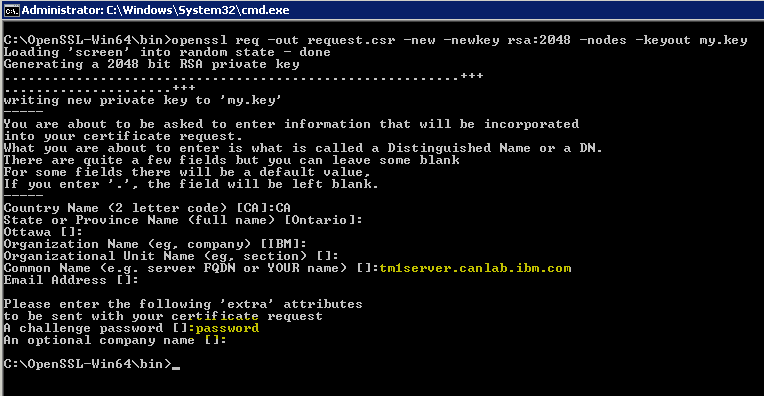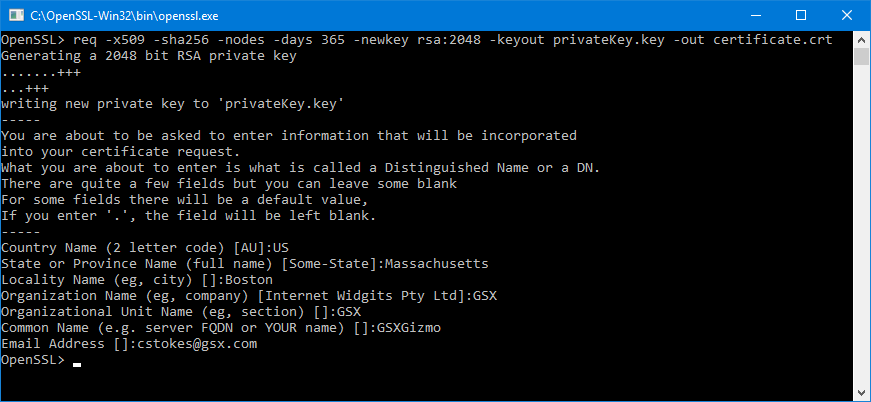While Encrypting a File with a Password from the Command Line using OpenSSLis very useful in its own right, the real power of the OpenSSL library is itsability to support the use of public key cryptograph for encrypting orvalidating data in an unattended manner (where the password is not required toencrypt) is done with public keys.
- Openssl Generate Aes Key Without Passphrase
- Generate Openssl Key Without Password Online
- Generate Openssl Key Without Password Free
- Generate Openssl Key Without Password Download
- Generate Openssl Key Without Password Windows 10
Generate Openssl Key Without Password Key Openssl Generate Password While Encrypting a File with a Password from the Command Line using OpenSSLis very useful in its own right, the real power of the OpenSSL library is itsability to support the use of public key cryptograph for encrypting orvalidating data in an unattended manner (where the. Make a new ssl private key:. Generate a new unencrypted rsa private key in PEM format: openssl genrsa -out privkey.pem 2048. You can create an encrypted key by adding the -des3 option. # To make a self-signed certificate:. Create a certificate signing request (CSR) using your rsa private key: openssl req -new -key privkey.pem -out certreq.csr.
The Commands to Run
Generate a 2048 bit RSA Key
You can generate a public and private RSA key pair like this:
openssl genrsa -des3 -out private.pem 2048
That generates a 2048-bit RSA key pair, encrypts them with a password you provideand writes them to a file. You need to next extract the public key file. You willuse this, for instance, on your web server to encrypt content so that it canonly be read with the private key.
Export the RSA Public Key to a File
This is a command that is

Openssl Generate Aes Key Without Passphrase
openssl rsa -in private.pem -outform PEM -pubout -out public.pem
The -pubout flag is really important. Be sure to include it.
Next open the public.pem and ensure that it starts with-----BEGIN PUBLIC KEY-----. This is how you know that this file is thepublic key of the pair and not a private key.
To check the file from the command line you can use the less command, like this:
less public.pem
Do Not Run This, it Exports the Private Key
A previous version of the post gave this example in error.
openssl rsa -in private.pem -out private_unencrypted.pem -outform PEM

The error is that the -pubout was dropped from the end of the command.That changes the meaning of the command from that of exporting the public keyto exporting the private key outside of its encrypted wrapper. Inspecting theoutput file, in this case private_unencrypted.pem clearly shows that the keyis a RSA private key as it starts with -----BEGIN RSA PRIVATE KEY-----.
Visually Inspect Your Key Files
It is important to visually inspect you private and public key files to makesure that they are what you expect. OpenSSL will clearly explain the nature ofthe key block with a -----BEGIN RSA PRIVATE KEY----- or -----BEGIN PUBLIC KEY-----.
You can use less to inspect each of your two files in turn:

less private.pemto verify that it starts with a-----BEGIN RSA PRIVATE KEY-----less public.pemto verify that it starts with a-----BEGIN PUBLIC KEY-----
Generate Openssl Key Without Password Online
The next section shows a full example of what each key file should look like.
The Generated Key Files
The generated files are base64-encoded encryption keys in plain text format.If you select a password for your private key, its file will be encrypted withyour password. Be sure to remember this password or the key pair becomes useless.
Generate Openssl Key Without Password Free
The private.pem file looks something like this:
The public key, public.pem, file looks like:
Protecting Your Keys
Depending on the nature of the information you will protect, it’s important tokeep the private key backed up and secret. The public key can be distributedanywhere or embedded in your web application scripts, such as in your PHP,Ruby, or other scripts. Again, backup your keys!
Remember, if the key goes away the data encrypted to it is gone. Keeping aprinted copy of the key material in a sealed envelope in a bank safety depositbox is a good way to protect important keys against loss due to fire or harddrive failure.
Oh, and one last thing.
If you, dear reader, were planning any funny business with the private key that I have just published here. Know that they were made especially for this series of blog posts. I do not use them for anything else.
Found an issue?
Rietta plans, develops, and maintains applications.
Learn more about our services or drop us your email and we'll e-mail you back.
Other Blog Articles Published by Rietta.com
If you have a PFX file that contains a private key with a password, you can use OpenSSL to extract the private key without a password into a separate file, or create a new PFX file without a password.
For those running macOS or Linux, I've created a Bash script to automate the process, which you can download from GitHub. You set the PFX_PASSWORD and PFX_FILE_IN variables at the top of the file with your own values, and don't forget to make it executable by running chmod +x pfx-remove-password.sh in Terminal.
For those running Windows, you can download OpenSSL for Windows binaries from SourceForge.
The manual instructions are below.
If you only want the private key file, you can skip steps 5 and 6.
Generate Openssl Key Without Password Download
If you want a PFX file with no password, you can delete TargetFile.Key when you're finished.

- MyPassword is your current password
- SourceFile.PFX is the PFX file you want to convert
- TargetFile.Key is the name of the private key file without a password that will be generated
- TargetFile.PFX is the name of the PFX file without a password that will be generated
1. Extract the certificate:
2. Extract the certificate authority key:
3. Extract the private key:
4. Remove the passphrase from the private key file:
5. Create a new input file to generate a PFX file:
6. Generate a new PFX file without a password:
Generate Openssl Key Without Password Windows 10
And that's it. For an input file named test-cert.pfx, you'll now have a private key file named test-cert.nopassword.key and a PFX file named test-cert.nopassword.pfx.

Reference: Serverfault